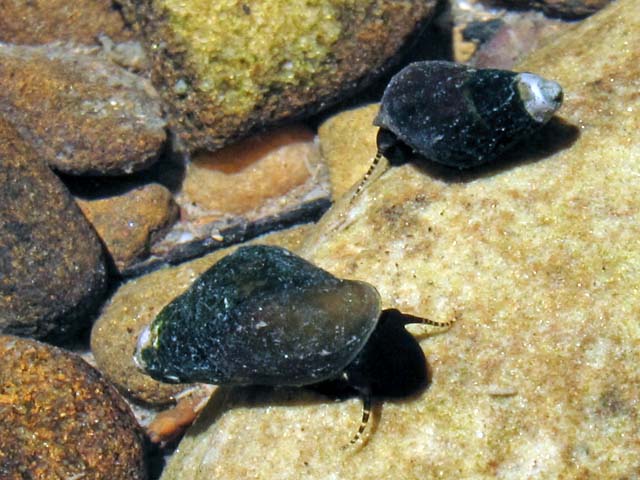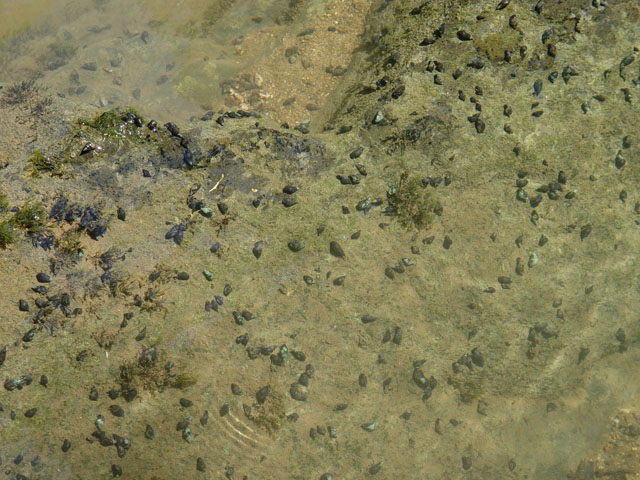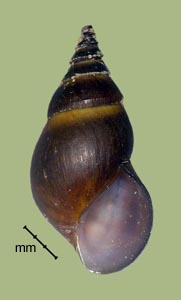Goniobasis or "Elimia" simplex
> Habitat & Distribution
The range of typical P. simplex was given by Goodrich (1940) as "headwaters of Tennessee River system in Virginia, Tennessee and North Carolina; Beaver Fork of Bluestone River of Kanawha River, Mercer County, West Virginia." Our observations do (indeed) confirm populations of P. simplex simplex reaching great densities in small, rich, hardwater streams extending from the upper New/Kanawha and upper Big Sandy drainages of West Virginia south through the Ridge and Valley Ecoregions of Southwest Virginia, East Tennessee, and North Georgia. The species does not extend, as far as we know, east through the Blue Ridge ecoregion into North Carolina.
Our broader surveys and improved understanding of the taxon have revealed a much larger range to the west, however, across the entire Tennessee/Cumberland drainage to its mouth at the Ohio, plus the Green River drainage in Kentucky. Throughout this extensive range, populations of P. simplex simplex generally reach maximum abundance in rich streams and smaller rivers with rocky substrate and good flow. Populations inhabiting larger and perhaps more nutrient-poor rivers bear paler, more robust shells and are identified as the subspecies P. simplex ebenum. The FWGNA incidence rank of the two subspecies considered together is I-5.
> Ecology & Life History
Grazing by populations of pleurocerids can have a significant effect on energy flow in small streams (Dillon 2000: 86 - 91, see also Dillon & Davis 1991).
Like other pleurocerids, P. simplex is dioecious, eggs being deposited on hard substrates from spring to mid-summer. Eggs are spirally arranged in masses of 2-15 or more, with a tough, membranous outer covering to which sand grains typically adhere (Smith 1980, Jokinen 1992). Although we are unaware of any study specifically directed toward the life history of P. simplex, it seems reasonable to expect that two years will be required for maturity, and that several years of iteroparous reproduction can be expected thereafter, as is the case for pleurocerids generally (Dazo 1965). This is life cycle Hi of Dillon (2000: 156 - 162).
> Taxonomy & Systematics
Two populations of P. simplex were included in the allozyme study of Dillon & Davis (1980) - one from a small tributary of the New/Kanawha River in SW Virginia, and the other from a tributary of the Middle Fork Holston River perhaps 10 km west. These populations were nearly identical at ten loci. Five additional populations were surveyed by Dillon & Robinson (2007a), including a sample from the type locality of the species in the North Fork Holston River at Saltville [pdf available below], and four more by Dillon (2011). The species is quite distinct genetically. There is no evidence of hybridization with either P. clavaeformis or P. troostiana, two other species of Pleurocera with which it often occurs. Pleurocera aterina (Lea 1863) is a synonym.
In 2012 we discovered, however, a cryptic species that often shares small-stream habitats in Southwest Virginia and East Tennessee with bona fide P. simplex populations (Dillon 2016a). While the ratio of apex height to body whorl height decreases with age in bona fide P. simplex populations, shells borne by populations of the cryptic Pleurocera gabbiana demonstrate A/B ratios increasing with age (Dillon & Robinson 2016, Dillon 2016b). See the P. gabbiana page for more details.
Our recent explorations in the Cumberland, Kentucky, and Green River drainages have returned evidence that pleurocerid populations previously identifed as P. ebenum are much more widespread than previously thought, and that they intergrade imperceptibly with the typical P. simplex populations of Tennessee drainages. It would appear that subspecific status for ebenum under simplex represents the biological situation most accurately. See my essays of 4Feb14 and 5Mar14 from the links below for discussions about the subspecies concept as adopted here.
We have also uncovered evidence that P. simplex, primarily the ebenum form, hybridizes with P. laqueata in numerous rivers and streams scattered around Middle Tennessee. Following Goodrich (1940), we identify such simplex/laqueata hybrid populations as Pleurocera laqueata castanea. See my essay of 21Nov24 from the link below.
Like most species of Pleurocera, the diploid number of P. simplex is 2N = 34 (Dillon 1989, 1991).
This species has travelled through three genera in thirty years. Although predominantly assigned to Goniobasis through most of the 20th century, in the 1980s many workers began placing it in the resurrected generic nomen, "Elimia." Both Goniobasis and Elimia were subsumed under Pleurocera by Dillon (2011). See my essay of 23Mar11 from the link below for more.
> Maps and Supplementary Resources
- Pretty photo of living P. simplex, courtesy of Chris Luckhaup.
- In-stream photo of P. simplex, courtesy of Alan Cressler.


> Essays
- Taxonomic controversy has surrounded the generic nomina Pleurocera, Goniobasis, and Elimia for many years. The best entry into the subject would be my essay of 23Mar11, entitled Goodbye Goniobasis, Farewell Elimia. Links are available from that essay to older resources.
- I expanded upon the concept of the subspecies, as we apply that term it here in the FWGNA project, in my essays of 4Feb14, What Is a Subspecies? and 5Mar14, What Subspecies are Not.
- I described the discovery of two species of Pleurocera cryptic under P. simplex in my essay of 13Sept16, "The Cryptic Pleurocera of Maryville."
- And see my follow-up essay of 14Oct16, "The fat simplex of Maryville matches type," to learn how I ultimately figured out which of the two cryptic species was the real P. simplex.
- In my blog post of 4Aug19, "CPP Diary: Yankees at The Gap," I documented a striking case of cryptic phenotypic plasticity in the population of P. simplex inhabiting a little stream that runs south out of Cumberland Gap, TN.
- In my follow-up essay of 3Oct19, "CPP Diary: What is Pleurocera (aka Melania, aka Goniobasis, aka Elimia) ebenum," I presented evidence that Isaac Lea's 1841 nomen ebenum is best understood as a pale, heavily-shelled subspecies of P. simplex. There are lots of excellent figures of ebenum in that post, both historical and recent.
- And in my follow-up of 4Sept19, "CPP Diary: The spurious Lithasia of Caney Fork," I documented an even more striking case of CPP in the P. simplex population inhabiting the Caney/Collins River system of Middle Tennessee. The shell phenotype of that population ranges from typical in the headwaters to ebenum in the middle reaches to a form that has been mistaken for Lithasia geniculata pinguis.
- I reviewed the evidence that populations of P. simplex (primarily the ebenum form) may hybridize with Pleurocera laqueata in Middle Tennessee to yield populations identified as Pleurocera laqueata castanea (Lea 1841). I also speculated about hybridization between P. simplex and P. semicarinata. Generalized across a variety of species and regions, such hybridization suggests Reticulate evolution in the North American Pleuroceridae.
- Systematic misidentification of P. simplex and P. gabbiana populations as P. clavaeformis contributed to the apparent polyphyly in the North American Pleuroceridae uncovered by Whelan et al. (2022). For more, see my essay of 14Oct25, Anchored hybrid enrichment and the prodigious clavaeformis confusion.
> References
Dazo, B. C. 1965. The morphology and natural history of Pleurocera acuta and Goniobasis livescens (Gastropoda: Cerithiacea: Pleuroceridae). Malacologia 3: 1 - 80.
Dillon, R. T., Jr. (1989) Karyotypic evolution in pleurocerid snails: I. Genomic DNA estimated by flow cytometry. Malacologia, 31: 197-203.
Dillon, R. T., Jr. (1991) Karyotypic evolution in pleurocerid snails: II. Pleurocera, Goniobasis, and Juga. Malacologia 33: 339-344.
Dillon, R. T., Jr. (2000) The Ecology of Freshwater Molluscs. Cambridge, Cambridge University Press. 509 pp.
Dillon, R. T., Jr. (2011) Robust shell phenotype is a local response to stream size in the genus Pleurocera (Rafinesque, 1818). Malacologia 53: 265-277.
Dillon, R. T., Jr. (2016a) Two reproductively isolated populations cryptic under Pleurocera simplex (Say, 1825) inhabiting Pistol Creek in Maryville, Tennessee. Ellipsaria 18(2): 15-16. [PDF]
Dillon, R. T., Jr. (2016b) Match of Pleurocera gabbiana (Lea, 1862) to populations cryptic under P. simplex (Say, 1825) Ellipsaria 18(3): 10 - 12. [PDF]
Dillon, R. T., Jr., & G. M. Davis (1980) The Goniobasis of southern Virginia and northwestern North Carolina: Genetic and shell morphometric relationships. Malacologia 20: 83-98.
Dillon, R. T. Jr., & K. B. Davis (1991) The diatoms ingested by freshwater snails: temporal, spatial, and interspecific variation. Hydrobiologia 210: 233-242.
Dillon, R. T., Jr., & J. D. Robinson (2007a) The Goniobasis ("Elimia") of southwest Virginia, I. Population genetic survey. Report to the Virginia Division of Game & Inland Fisheries, 25 pp. [PDF]
Dillon, R. T., Jr. & J. D. Robinson (2016) The identity of the "fat simplex" population inhabiting Pistol Creek in Maryville, Tennessee. Ellipsaria 18(2): 16-18. [PDF]
Goodrich, C. (1913) Spring collecting in southwest Virginia. Nautilus 27: 81-82, 91-95.
Goodrich, C. (1940) The Pleuroceridae of the Ohio River drainage system. Occas. Pprs. Mus. Zool. Univ. Mich., 417: 1-21.
Jokinen, E.H. 1992. The Freshwater Snails (Mollusca: Gastropoda) of New York State. NY State Mus Bull 482, Albany, New York.
Smith, D.G. 1980. Goniobasis virginica Gastropoda Pleuroceridae in the Connecticut River USA. Nautilus 94:50-54.
Stewart, T. W., & R. T. Dillon, Jr. (2004) Species composition and geographic distribution of Virginia's freshwater gastropod fauna: A review using historical records. Am. Malac. Bull. 19: 79-91.
Whelan, N. V., Johnson, P. D., Garner, J. T., Garrison, N. L., & Strong, E. E. (2022) Prodigious polyphyly in Pleuroceridae (Gastropoda: Cerithioidea). Bulletin of the Society of Systematic Biologists, 1(2). https://doi.org/10.18061/bssb.v1i2.8419








